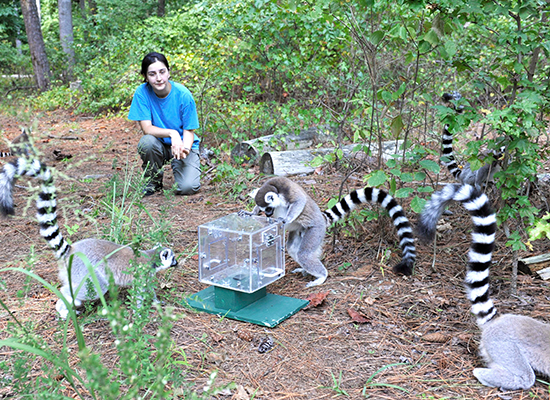Curiosity and knowledge prompt discovery. Discovery prompts action. And the more we learn about lemurs, the better we are able to protect them in the wild, care for them in captivity, and engage the public to not only care, but to participate. And how do we discover? Through research!
The Duke Lemur Center houses more than 200 individual animals representing 13 species. We are home to nocturnal, diurnal, and cathemeral animals, as well as species that encompass a wide range of social systems, modes of locomotion, and dietary preferences.
Such variety yields a large and diverse research program, but the one thing that all DLC research has in common is that all is non-harmful. The DLC does NOT allow research that will harm the animals.
Why does the DLC study lemurs?
Lemurs have fascinated scientists for centuries. There are many reasons to study lemurs—indeed, too many to list here—but here are some of our favorite reasons:
Because of lemurs’ history and diversity: When the ancestors of today’s lemurs serendipitously rafted from mainland Africa to Madagascar some 50 million years ago, they became isolated from the rest of the world. Thus, launched one of the greatest natural experiments in primate evolution. Since then, 125 species of lemur (and counting) evolved from these early pioneers in Madagascar, where they developed diverse strategies to cope with challenge and take advantage of opportunity. Studying lemurs, and their unique history in Madagascar, allows us to study the evolutionary, ecological, and anthropogenic processes that can shape biodiversity itself.
Because lemurs are endangered: Although lemurs have thrived for tens of millions of years, human activity has now rendered them among the most endangered vertebrates on Earth. The threats facing lemurs include habitat loss and fragmentation, increasingly frequent and extreme weather events, changing landscapes and climate, poaching and hunting. As lemur researchers, we cannot ignore the omnipresent conservation concerns facing the animals we study. Rather, we can use research-based initiatives to develop sustainable solutions that are firmly grounded in team-based and integrative approaches.
Because lemurs are part of our family: As primates, lemurs are our most distant relatives within our own family tree. Studying lemurs within a comparative context across primates allows us to understand ourselves, and the traits and processes that make us both primate and human. Moreover, we share with lemurs the vast majority of our genetic code and many of the same diseases, susceptibilities, and health concerns: Studying lemurs could potentially help us find solutions to combat serious problems facing modern society.
What exactly is a lemur?
Lemurs are primates like no other. Lemurs belong to a group called the strepsirrhine primates, which also includes the lorises, bushbabies, and pottos. The word ‘strepsirrhine’ reflects the shape of the animals’ noses: The etymology comes from the Greek words strepsis (“turning round”) and rhinos (“nose”). Sometimes, strepsirrhines are called the wet-nosed primates, reflecting the moist rhinarium on the tips of their noses (the better to smell you with, my dear!).
Lemurs share many traits with other primates: They have relatively big brains, grasping hands, fingernails, and forward-facing eyes. They’re generally social, invest heavily in offspring, and live long lives. They also have traits that are unusual among primates, like a toothcomb, a grooming claw, and eyes that are not fully encased in bone. Lemurs more often give birth to twins or litters, rely on scent marking, and represent an exceptional wealth of nocturnal and folivorous species.
All in all, there are 108 recognized lemur species in Madagascar that belong to 15 genera in 5 phylogenetic families. In addition, there are at least 17 lemur species that have gone extinct in Madagascar, including many giant lemurs that once roamed the great red island. We invite you to check out the DLC Museum of Natural History to learn more about these lost cousins of today’s lemurs.
What types of research happen at the DLC?
The Duke Lemur Center hosts an array of research projects spanning diverse fields of study. In particular, the DLC provides opportunity for observational and experimental research under ecologically relevant and controlled settings. Because all DLC research is minimally invasive and non-harmful to the animals, an extensive and curated specimen BioBank enables projects that cannot be performed with our living collection. In addition, the DLC Museum of Natural History houses more than 35,000 fossils and subfossils that are available for study.
The DLC has two research themes, occurring on-site and in Madagascar, that are spearheaded by DLC staff scientists: hibernation and the gut microbiome. Other research projects are led by external researchers, including students, postdoctoral fellows, and faculty across the globe. We welcome new researchers and new projects. If you are interested in researching at the DLC, please see our information for external researchers.
DLC Research Advisory Committee
In 2019, the DLC formed a new standing Research Advisory Committee (RAC) that meets routinely to help advise the DLC on the development of strategies and collaborations needed to strengthen its research program. Current RAC members include:
Doug M. Boyer, Duke University
Christine M. Drea, Duke University
Mitch T. Irwin, Northern Illinois University
Peter A. Larsen, University of Minnesota
Kathleen M. Muldoon, Midwestern University
John F. Rawls, Duke University
Alexandra G. Rosati, University of Michigan
Daniel O. Schmitt, Duke University



